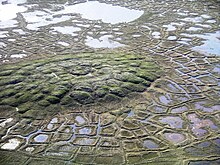Landform
Landforms or relief forms are a general name for the surface shapes of the land. Together they form the relief . A mountain or an atoll is a landform. The word is closely related to the shape of the terrain , a more specific term that describes the country in a geometrically abstract way, for example for a map. A landform can also highlight geology or formation. Landscaping elements , however, are generally to be understood more generally as a land form, they include the ecology (water, forests) and construction (stone walls, houses) with one and together form the landscape.
A landform has a unity, a commonality that separates it from its surroundings. More specific terms go into it, e.g. B. landforms on flowing water (fluvial landforms), or the specific landforms, such. B. Berg.
Research subject
The description and classification of landforms is a research topic in geomorphography (landform science ) . The soil and possible references to its formation (e.g. grinding marks of a glacier on the rock) are also described. Rock formation information comes from structural geology . Subsequently, the department of general geomorphology can investigate the formation of land forms and their relationships.
The fields of cartography , topography and photogrammetry are also involved in relevant research, as well as planetology , albeit on other planets .
Landform by geometry: Terrain shape
Terrain forms describe the land mainly with geometric means. These means include shape, inclination, direction ( exposure ), height and extent. Terrain forms describe the land in general, even without special features such as water bodies, glaciers or prominent vegetation. Little consideration is given to development processes or dependencies.
Land form according to origin and location
If one judges a country according to its formation, other contiguous areas may develop than by geometry. The development is usually closely related to the location. Water or glaciers are at least one factor in the formation of the land forms they shape. The artificial landform is an exception, it has nothing to do with its location.
Most variants of land formation, i.e. the relief-forming processes, have typical land forms. They are therefore also classified according to the formation processes known from geomorphology. Namely roughly in:
- endogenous (land-forming) formation, i.e. volcanism and tectonics
- exogenous (land-deforming) formation, i.e. erosion (also erosion) and sedimentation
- artificial creation
- cosmic origination
More accurate:
Volcanogenic forms
Endogenous land forms that are not significantly affected by erosion are of volcanic origin on earth . A volcanic cone or caldera are volcanogenic landforms. Tectonic mountain forms, on the other hand, also originally endogenous forms, are almost always influenced by exogenous forces.
Gravitational forms
The simplest exogenous, i.e. eroded or accumulated, landform was created by gravity , sometimes with the help of water. Examples: Talus (rubble dump), demolition niche in a landslide
Periglacial forms
Periglacial land forms are the result of ground ice that occurs seasonally or as permafrost soil. Example: frost pattern floor
Glacial forms
The glacier dominates or dominated the formation of glacial landforms. The glacier itself and its forms on it are also land forms. Subglacial forms under the glacier are part of this when the glacier is gone in the meantime (e.g. glacier mill , trough valley )
Fluvial forms
The water itself belongs to the land forms only marginally, but its surroundings do. The shaping influence for fluvial land forms is the flowing water, e.g. B. in the Kerbtal or in the alluvial fan . In connection with glacial formation, fluvioglacial forms result.
Marine and Limnic Forms
Land forms created by the sea or lakes such as cliffs , beaches , marshes
Aeolian forms
Land forms created by the wind occur mainly in arid climates such as the desert. E.g .: dune , stone pavement
Karst forms
Karst was created through karst processes. You form z. B. karst caves or sinkholes , including gypsum caves .
Other exogenous forms
Some relief-forming processes do not form characteristic landforms, e.g. B. groundwater processes, or they are to be assigned to other categories, such as many biogenic land forms, z. B. Coral reefs . For the rest of the exogenous forms this group is. These can be leveling hollows created by snow , or rocking stones or anthills. The latter are actually more objects than landforms.
Artificial forms
Land forms of different types were created directly by human actions, such as quarries or artificial islands .
Cosmogenic forms
Earthly forms, the cause of which was a heavenly body, have cosmogenic origins, e.g. B. a meteorite crater . The landform also exists in cosmic objects themselves, where it can occur far more frequently.
Landform by extent
Landforms with an extension in the order of magnitude of 100 m to kilometers are assigned to the mesoscale , they belong to the meso relief . Examples are mountain, valley, hill, and the like. Smaller forms of the size below are arranged , for example the embankment. There are also landscape forms .
See also
Individual evidence
- ↑ Introduction to Geomorphology, page 13, textbook (online reading sample) by Frank Ahnert, 1996.
- ↑ Relief-forming processes ( Memento of the original from September 15, 2014 in the Internet Archive ) Info: The archive link was inserted automatically and has not yet been checked. Please check the original and archive link according to the instructions and then remove this notice. , Collection of articles, PG-Net project, Free University of Berlin.
- ↑ Natural areas of Latin America - from Tierra del Fuego to the Caribbean , scientific work by Axel Borsdorf and Hannes Hoffert, accessed in 2014.
- ↑ Mesorelief , glossary, project GEOVLEX the Martin Luther University of Halle-Wittenberg, 2008, accessed, 2014.






